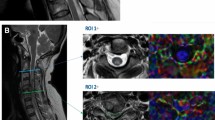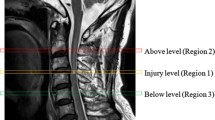Abstract
Introduction
We analyzed the findings of diffusion-weighted (DW) imaging using the single-shot fast spin-echo sequence in acute cervical cord injury and evaluated the usefulness of this method for predicting the prognosis.
Methods
Our patient group comprised 14 patients examined 2 h to 3 days after injury. First, we visually evaluated the DW imaging findings in all patients. Apparent diffusion coefficient (ADC) maps were also assessed in 13 patients. Second, we assessed follow-up magnetic resonance (MR) examinations obtained in six patients whose DW images showed hyperintensity. Third, we reviewed the functional outcome at discharge.
Results
The lesions showed hyperintensity in ten patients, and no abnormal signal was noted in the remaining four patients. The ADC maps showed restricted diffusion in all patients with hyperintensity on DW imaging except in one patient for whom the ADC map was unavailable. Repeated MR examinations obtained in six of the ten patients showed either myelomalacia or exacerbation. Seven of the ten patients (70%) required assistance and the other three were independent. Among the four patients without hyperintensity on DW imaging, three (75%) were independent and only one required assistance.
Conclusion
DW imaging in acute cervical cord injury often reveals restricted diffusion. This finding may predict an unfavorable functional prognosis.



Similar content being viewed by others
References
Beers GJ, Raque GH, Wagner GG, Shields CB, Nichols GR 2nd, Johnson JR, Meyer JE (1998) MR imaging in acute cervical spine trauma. J Comput Assist Tomogr 12:755–761
Flanders AE, Schaefer DM, Doan HT, Mishkin MM, Gonzalez CF, Northrup BE (1990) Acute cervical spine trauma: correlation of MR imaging findings with degree of neurologic deficit. Radiology 177:25–33
Kerslake RW, Jaspan T, Worthington BS (1991) Magnetic resonance imaging of spinal trauma. Br J Radiol 64:386–402
Barzo P, Marmarou A, Fatouros P, Hayasaki K, Corwin F (1997) Contribution of vasogenic and cellular edema to traumatic brain swelling measured by diffusion-weighted imaging. J Neurosurg 87:900–907
Liu AY, Maldjian JA, Bagley LJ, Sinson GP, Grossman RI (1999) Traumatic brain injury: diffusion-weighted MR imaging findings. AJNR Am J Neuroradiol 20:1636–1641
Robertson RL, Maier SE, Mulkern RV, Vajapayam S, Robson CD, Barnes PD (2000) MR line-scan diffusion imaging of the spinal cord in children. Am J Neuroradiol 21:1344–1348
Fujikawa A, Tsuchiya K, Takeuchi S, Hachiya J (2004) Diffusion-weighted MR imaging in acute spinal cord ischemia. Eur Radiol 14:2076–2078
Tsuchiya K, Katase S, Fujikawa A, Hachiya J, Kanazawa H, Yodo K (2003) Diffusion-weighted MRI of the cervical spinal cord using a single-shot fast spin-echo technique: findings in normal subjects and in myelomalacia. Neuroradiology 45:90–94
Ford JC, Hackney DB, Alsop DC, et al (1994) MRI characterization of diffusion coefficients in a rat spinal cord injury model. Magn Reson Med 31:488–494
Nevo U, Hauben E, Yoles E, et al (2001) Diffusion anisotropy MRI for quantitative assessment of recovery in injured rat spinal cord. Magn Reson Med 45:1–9
Schwartz ED, Yezierski RP, Pattany PM, Quencer RM, Weaver RG (1999) Diffusion-weighted MR imaging in a rat model of syringomyelia after excitotoxic spinal cord injury. Am J Neuroradiol 20:1422–1428
Sagiuchi T, Tachibana S, Endo M, Hayakawa K (2002) Diffusion-weighted MRI of the cervical cord in acute spinal cord injury with type II odontoid fracture. J Comput Assist Tomogr 26:654–656
Schwartz ED, Chin CL, Takahashi M, Hwang SN, Hackney DB (2002) Diffusion-weighted imaging of the spinal cord. Neuroimaging Clin N Am 12:125–146
Demediuk P, Lemke M, Faden AI (1990) Spinal cord edema and changes in tissue content of Na+, K+, and Mg++ after impact trauma in rats. Adv Neurol 52:225–232
Tator CH, Fehlings MG (1991) Review of secondary injury theory of acute spinal cord trauma with emphasis on vascular mechanisms. J Neurosurg 75:15–26
Conflict of interest statement
We declare that we have no conflict of interest.
Author information
Authors and Affiliations
Corresponding author
Rights and permissions
About this article
Cite this article
Tsuchiya, K., Fujikawa, A., Honya, K. et al. Value of diffusion-weighted MR imaging in acute cervical cord injury as a predictor of outcome. Neuroradiology 48, 803–808 (2006). https://doi.org/10.1007/s00234-006-0133-9
Received:
Accepted:
Published:
Issue Date:
DOI: https://doi.org/10.1007/s00234-006-0133-9




